Polonnaruwa was the second capital of Sri Lanka after the destruction of the ancient city of Anuradhapura in 993. Sidenote: I’d like to say that due to their length, these Sri Lankan names are very Social Media-unfriendly.

Apart from the Brahmanic monuments built by the Cholas, Polonnaruwa consists of the monumental ruins of the garden-city created by Parakramabahu I in the 12th century.
Just like the Sacred City of Anuradhapura, it has been on the UNESCO-list of World Heritage Sites since 1982.
And I like it much better – due to three reasons.
- Three Reasons to Prefer Polonnaruwa over Anuradhapura
- POLONNARUWA
- Pothgul Viharaya and Statue of King Parakramabahu I
- The Palace Complex of King Nishshanka Malla
- The Palace Complex of King Parakramabahu I
- The Polonnaruwa Vatadage | Hetadage | Nisshankalatha Mandapa | Thuparama Pilimage
- Shiva Devale No 2 and Ancient Vishnu Shrine
- Rankoth Vehera
- Lankatilaka Viharaya and Kiri Vehera
- Gal Viharaya
- Thivanka Image House
- Practical Information
- Pinnable Pictures
Three Reasons to Prefer Polonnaruwa over Anuradhapura
Reason #1
Firstly, it’s smaller and more compact and overseeable. The archeological site covers basically two areas, a long one in the north and a small spot in the south. Therefore, once you get there, you can peacefully cycle from ruin to ruin. When you are wearing shorts or a sleeveless top, you cover up with a sarong or a shawl, you take off your hat and your shoes and you are good to go for an inspiring visit.

In general, they are super-strict with these rules. As soon as they spot someone not dressing appropriately, they call that person out. And if you don’t have anything to cover, you wait outside; simple as that.
However, I don’t get why they don’t make a business of this – as they do for instance in Bali: At every temple, there is someone waiting, ready to sell you a sarong so you can enter. Actually a win-win situation for both sides – but here, they don’t do it.
Once you’re done, you put on your shoes, take off the sarong – what a relief that is in the hellish heat – and off you cycle to the next spot. Perfect.

Not only did I keep losing my way in Anuradhapura, it’s also far more tiring visiting the sites there cycling since they are so far from each other.

Don’t get me wrong, I like big cities. But when they are big, they have to feel big. There has to be a central square, shops, maybe a small mall, cafés, and restaurants. A metropolis. Not extended dirt roads.
Reason #2
And that brings me to the second reason why I prefer Polonnaruwa, and this one is totally unfair: Anuradhapura was my first stop.
I didn’t even have a culture shock. I cycled crisscross town from the first minute. Still, I needed some time to grasp the concept of what is a city like in Sri Lanka.
The same thing happened to me before, for instance in Los Angeles. I’m totally European, so a city to me has to have some sort of clear nucleus, a point of orientation, a center. What’s considered the old center in Los Angeles is the dullest neighborhood of the entire city. Therefore, I didn’t like it, I found that confusing. Once I grasped their concept of a city, I was fine and able to adapt – and to enjoy.
So that Anuradhapura didn’t feel like a city to me got me a bit irritated.
When I came to Polonnaruwa, this concept wasn’t new to me anymore and didn’t put me off.
Reason #3
The third reason why I prefer Polonnaruwa over Anuradhapura has not really to do with the cities but with the accommodation I chose. Instead of booking myself in a middle-class hotel, I made a reservation at the Sun Guest House*. It’s a four-room accommodation run by a charming middle-aged man who was already as sweet as can be via WhatsApp before I’d even arrived.
Although his house is practically in the city center, it is right next to rice paddies – remember: Different concept of cities in Sri Lanka.
The rooms are certainly not luxurious, but they are spotlessly clean and you find everything you need. And if there actually should be something you’re missing, the owner Sumith goes out of his way to arrange it for you.

It reminded me a bit of my trip to Cuba where I used to stay in Casas Particulares, nothing but a different name for homestay, and also of my trip to Croatia last summer where I mostly rented privately owned Apartman.
Even if I hadn’t been a great fan of homestays, anyway, the dinner Sumith’s wife prepared for me would convince me to never book a standard hotel room again.
POLONNARUWA
Polonnaruwa was not only the second most ancient of Sri Lanka’s kingdoms, but it was also my second stop on the trip through Sri Lanka.
Around the central lake, the Parakrama Samudra, built in 1200, there are lush greenery and verdurous rice paddies. Populations of toque macaques, a reddish-brown-colored monkey endemic to Sri Lanka are roaming the archeological sites while the luckiest ones can spot herds of elephants on the opposite shore of the lake.

Polonnaruwa’s strongest suit, nevertheless, are the remnants of the archaeological relic sites. To this date, they stand testimony to the greatness of the Kingdoms. The same year as Anuradhapura, Polonnaruwa has been declared a World Heritage site by UNESCO in 1982 – and is consequently one of Sri Lanka’s eight sites on the list.
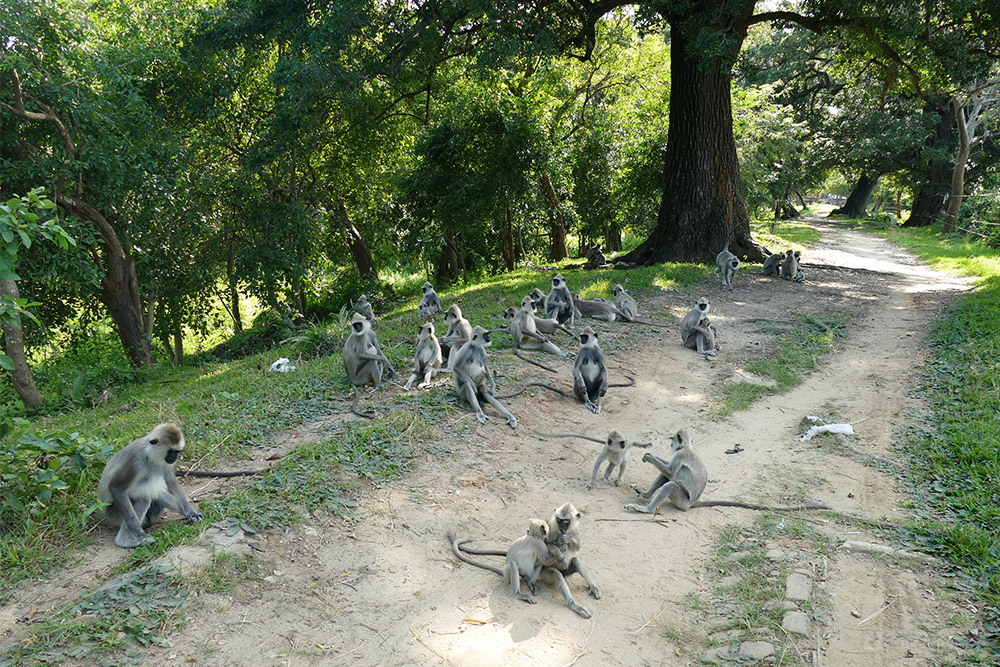
Yes, you should explore Polonnaruwa over at least one or two days.
For doing so, you can, of course, hire a tuk-tuk. People are even doing it on organized tours. I personally find that exploring places like these archeological sites is much more fun when you can just meander around as you please. It brings you closer to the sites, nature, the people…in short, it grants a complete experience.

Let’s move on, just like Anuradhapura, from the south towards the north.
Coming from the clocktower, you get to the lake at the so-called 1st Canal. Here is the Archeological Museum where you can buy a ticket to the ruins. As in Anuradhapura, it costs the equivalent of 25 US$ and is valid only for one day.
Pothgul Viharaya and Statue of King Parakramabahu I
As you cycle down south, after about ten minutes, you’ll reach the Pothgul Viharaya, the oldest library complex found in Sri Lanka. King Parakramabahu I commissioned them in the very early 12th century.
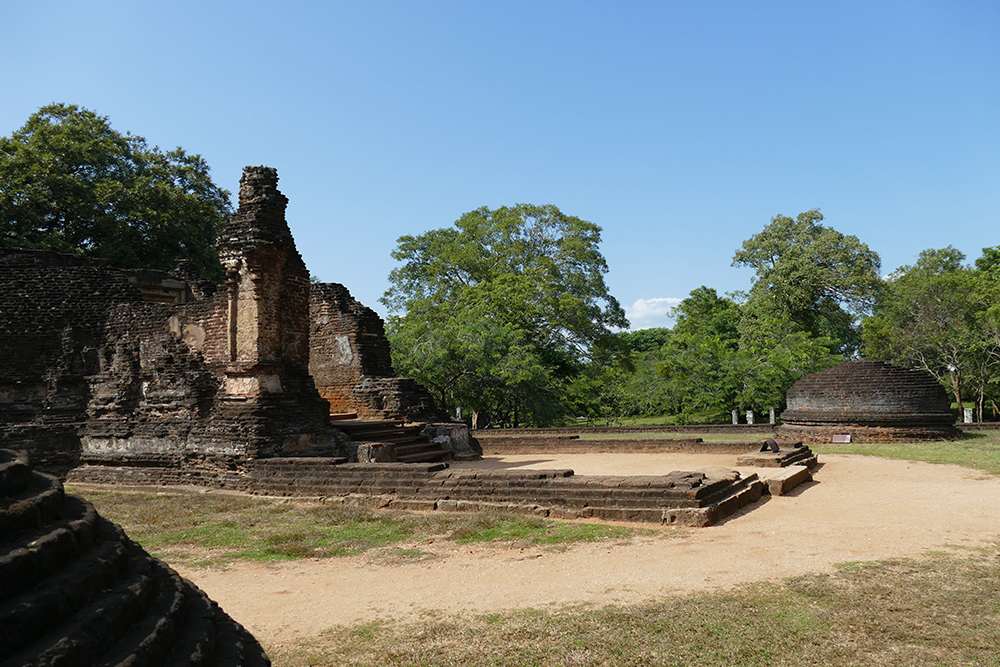
And you even have the pleasure of meeting this important monarch since there is a statue depicting his majesty on the premises. Carved on a large boulder, he is probably holding a book in his hands.

Actually, that’s it for this part of town. Now you can cycle back to the Archeological Museum where you can leave your bike on the parking lot – unless you don’t mind to schlepp it across the adjacent complex of King Nishshanka Malla’s Palace in order to continue from there.
The Palace Complex of King Nishshanka Malla
King Nishshanka Malla ruled in the very late 12th century. By declaring that only a Buddhist had the right to rule the country, he secured his position and justified his claim for kingship. Unfortunately, this idea was recycled not so long ago during the civil war.
The King spent large sums for constructions and refurbishments.
The so-called Nishshanka Latha Mandapaya is a unique type of building that contains 8 granite pillars supporting the roof. These pillars are carved out of granite in the form of lotus stems with opening lotus buds on the tops, and are positioned on a platform.
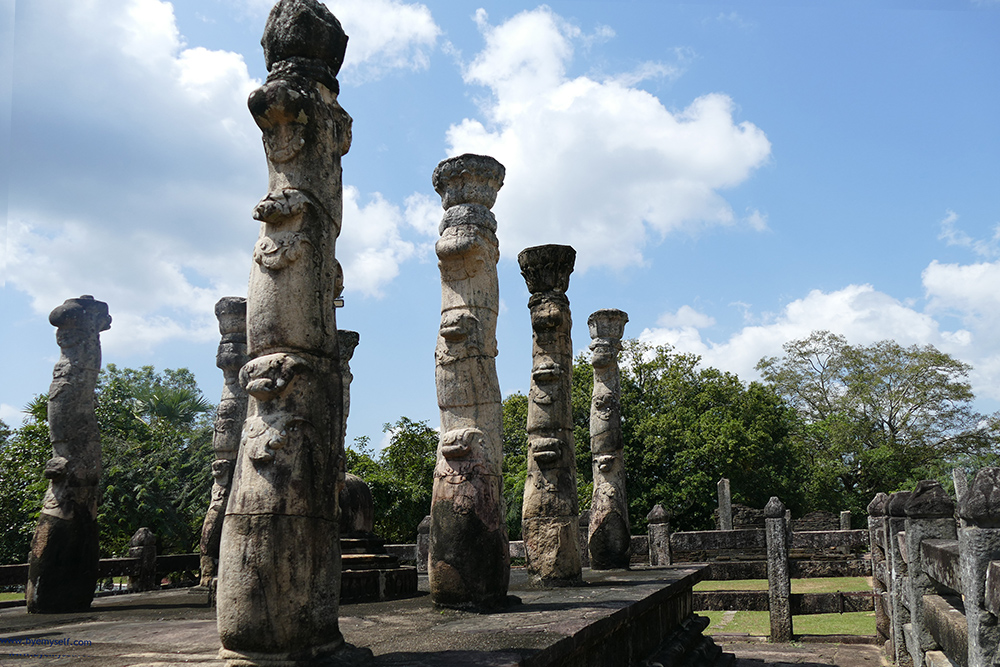
But also other structures like the Hetadage, built to store the Relic of the Tooth of the Buddha, and the Rankot Vihara, the fourth largest stupa in Sri Lanka, were commissioned by King Nishshanka Malla as well as the refurbishment of the rock temple in Dambulla where he had 50 Buddha statues in the temple gilded.

At this complex, however, there are the remnants of the Old Sluice, the King’s Palace, his Chamber House, and the Mausoleum.

From here, you can easily get to the main part of the archeological park: Just follow the Royal Palace Pathway and you’ll reach the freeway. Across this road is the main entrance to the site.
The Palace Complex of King Parakramabahu I
Turning right at the main entrance, you’ll get to the Palace Complex of King Parakramabahu I with the remnants of the Royal Palace to your right. It’s said that it used to be seven storeys high and has about 1000 chambers. You can still see the massive walls over a meter thick going up about nine meters / 30 feet high.

In the main Palace’s vicinity, there are remains of more buildings where the ministers, soldiers, and servants lived.



Tip: To see what all these places must have looked like, make sure to visit the Archeological Museum at the end of your tour. There are documents, photos, and even miniature models of many of these sites.
The Polonnaruwa Vatadage | Hetadage | Nisshankalatha Mandapa | Thuparama Pilimage
This complex lies up north on the other side of the entrance gate. Since this is a sacred area, you need to take off your shoes and cover up.
The Polonnaruwa Vatadage is believed to have been built during the reign of Parakramabahu I or Nishshanka Malla to hold the Relic of the tooth of the Buddha.
The Vatadage is amazingly well preserved. Supposedly, some of the carvings are the best examples of such architectural features.

On the opposite side of the Vatadage is the Hatadage, a relic shrine. King Nishshanka Malla commissioned it to keep the Relic of the tooth of the Buddha. The Hatadage was built from stone, brick, and wood. Although today, only parts of the brick and stone walls remain. There are still three Buddha statues carved out of granite standing at a chamber of the shrine.

The Nisshankalatha Mandapa is a pillared structure, open on all sides. A roof protects the from the sun. As already mentioned, King Nishshanka Malla commissioned these structures. Therefore, they were named after him. He probably used this structure to listen to the chanting of Buddhist scriptures.
The most outstanding feature are the stone pillars. They are carved in the shape of lotus stems with opening buds on the tops. This design is absolutely unique even within Sri Lanka.
Now, the Thuparama Image House is one of the few buildings where you can see a roof completely made out of bricks. Almost the entire building has survived for over 900 years – so no wonder there are scaffolds all around the walls now. The roof is semi-cylindrical in shape.
It is believed that this building, too, was constructed to house the tooth relic.
Shiva Devale No 2 and Ancient Vishnu Shrine
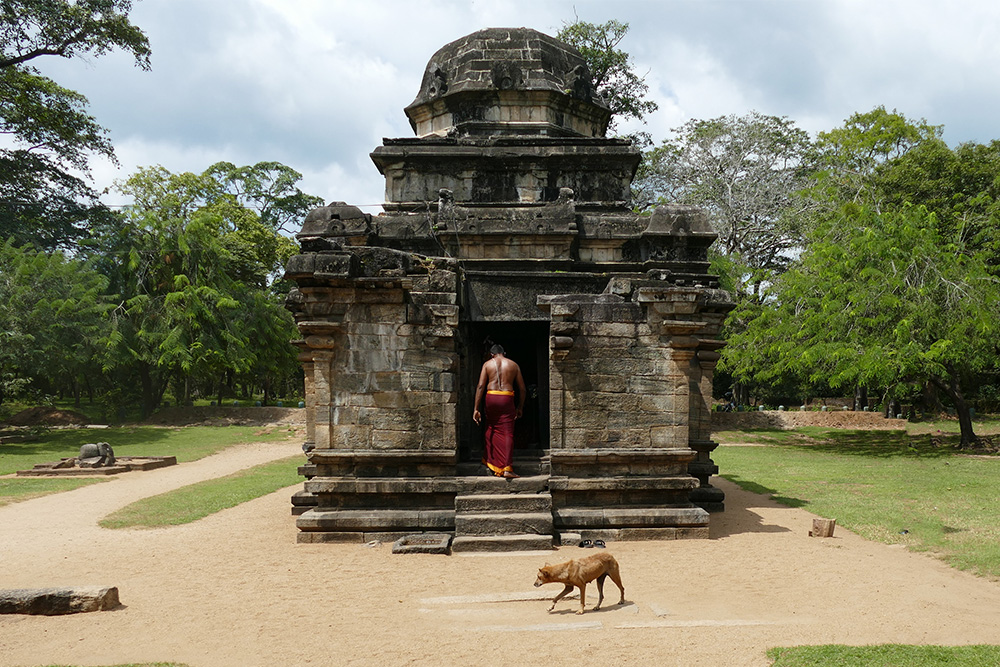
Since you keep on to the north, you’ll get to a small junction. Turn right to get to the Shiva Devale No. 2 – which is the oldest structure in Polonnaruwa. It was built by the Chola rulers who annexed Sri Lanka in the late 10th century.

Rankoth Vehera
King Nishshanka Malla commissioned the Rankoth Vehera stupa. It was built according to the tradition of the stupas of the Anuradhapura Maha Viharaya. Since Rankoth Vehera can be translated as Gold Pinnacled Stupa, it must have been stupefying in its better days; or is it stupafying?!

Anyway, besides the Kiri Vehera, it is one of the most revered stupas in Polonnaruwa.
Lankatilaka Viharaya and Kiri Vehera
And yet, here we are at the Kiri Vehera, the second largest stupa in Polonnaruwa today. Also, it is the only stupa that actually survived around 900 years. It is said to be built by a wife of King Parakramabahu I.

Right next to it is the Lankathilaka Image House, a monolithic Buddha image house built by King Parakramabahu I. The structures are made of bricks, the outer walls are covered with elaborate carvings.
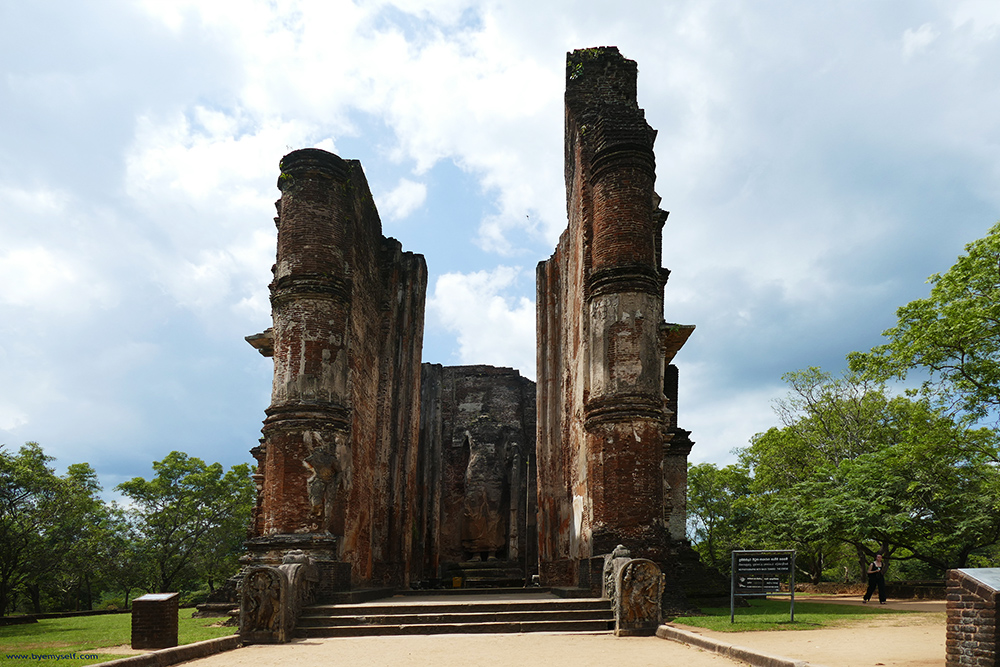

The Buddha statue is 12,5 meters high and made of clay bricks. Two massive pillars are flanking the entrance to the Lankathilaka Image house. The tallest is 17,5 meters high. However, these pillars are said to have been at least twice as tall before destruction. According to chronicles, the Lankathilaka Image house had five storeys.
The Lankatilaka Viharaya, as well as the Kiri Vehera, is part of the Alahana Privena Monastic Complex.
Gal Viharaya
The Gal Viharaya is a rock temple of the Buddha, fashioned in the 12th century by King Parakramabahu I.

The central piece of the temple is four Buddha statues, carved into a large granite rock.

The images consist of a large seated Buddha, another smaller seated figure inside a cavern, a standing one, and a reclining Buddha.

Gal Viharaya is one of the most popular Sri Lankan landmarks.
Thivanka Image House
Also, the Thivanka Pilimage, the Thivanka Image House, was commissioned by King Parakramabahu I. It’s part of the Jethavanarama Complex.
Like most other structures of this era, this complex is built from bricks – including the Buddha statue which was about 8 meters high. However, today it is only 6,6 meters tall. That’s because the upper part has been destroyed.
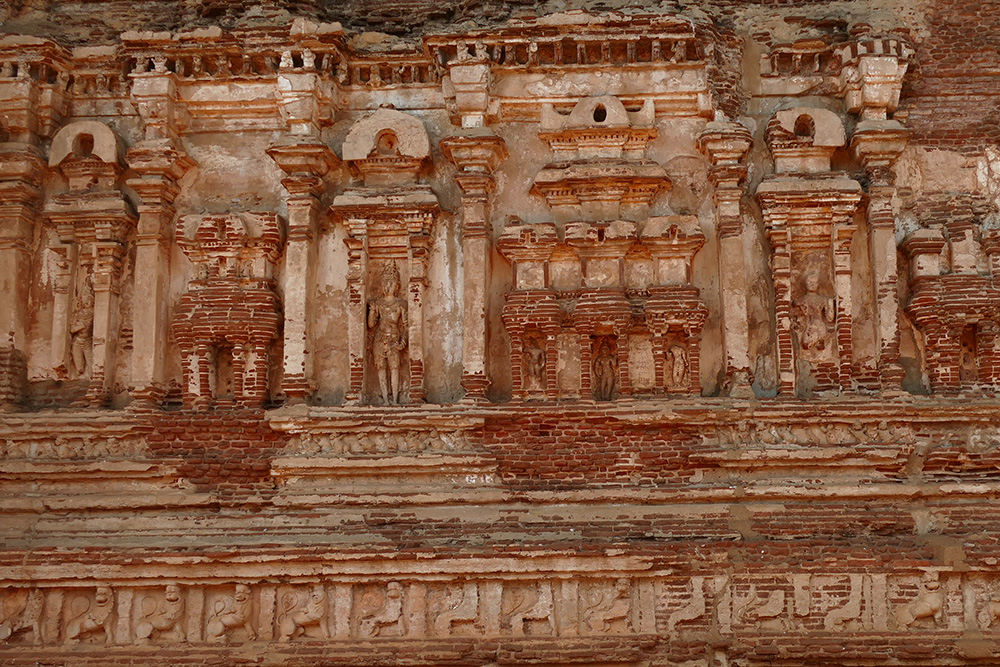
Besides the Buddha, the inside walls of the buildings are decorated with frescoes picturing the Jataka Stories, the time prior to Buddha’s enlightenment.
Practical Information
How to Get There
There are public buses going from Anuradhapura to Polonnaruwa – the ride takes about two to three hours.
Also, Polonnaruwa is less than 60 kilometers from Sigiriya. Although there is no direct bus from Polonnaruwa to Sigiriya, it’s fast and not complicated to get there. First, you go to the Inamaluwa junction, there you can change for the bus to Sigiriya. At Inamaluwa junction, buses run about every 30 minutes until 6 p. m.
How to Get Around
In general, the roads of Polonnaruwa are not very busy. Also, there are many side streets and trails. Therefore, cycling is a valid option. Especially exploring the archeological site by bicycle is great fun.
I love the fact that you can stop everywhere you like to enjoy a spot or take some pictures.
However, it is hot and humid and the bikes might not be a bit hard to ride. Of course, you can always charter a tuk-tuk for the day.
Best Place to Sleep
Stayin at the Sun Guest House lifted my stay to a whole different level: It is in the perfect location about five minutes away from the major archeologic sites, right in the middle of the Old Town.
The strongest feature, though, is the owner who is not only friendly and fun but actually goes out of his way to arrange things for you and make your stay an enjoyable one.
Get more details, check out availability and the Sun Guest House *
If the Sun Guest House should be booked out or if you simply want to search for other convenient options, you can do so right on this map*:
Booking.comBest Place to Eat
I had read in some reviews that the food at the Sun Guest House was really good – so I gave it a try. What can I say – that was a really smart decision since the host’s curry was some of the best food I had during my whole trip.

What to See
I’m an avid solo-travelling woman. Since solo-travel doesn’t equal solitude, I love to join organized tours here and there. They allow me to meet fellow travellers – for just a short moment or a lifelong friendship.
Therefore, here are some great ideas of what to do and which tours to join during your stay in Sri Lanka*:
Best Place to Shop
Close to the clock tower is a local market taking place. Besides seeing local people shop for fresh, exotic produce it is a good place to buy some not-so-very touristy souvenirs like for instance fabric and sarongs.

Cash And Cards
Sri Lanka’s currency is called rupee, generally called Rs., but LKR is the official abbreviation. The rate is 1 US$ = 365 LKR current rate resp. 1 €UR = 389LKR current rate as of December 2022.

Credit cards are not as widely accepted as in other countries. However, there are various banks with ATMs in Polonnaruwa so getting cash is no biggie.
Do you want to read about all the other beautiful places I’ve visited in Sri Lanka? Then go to the main post and take your pick! There you’ll also find valuable general information that will make your trip smoother.
Pinnable Pictures
If you choose to pin this post, please use one of these pictures:
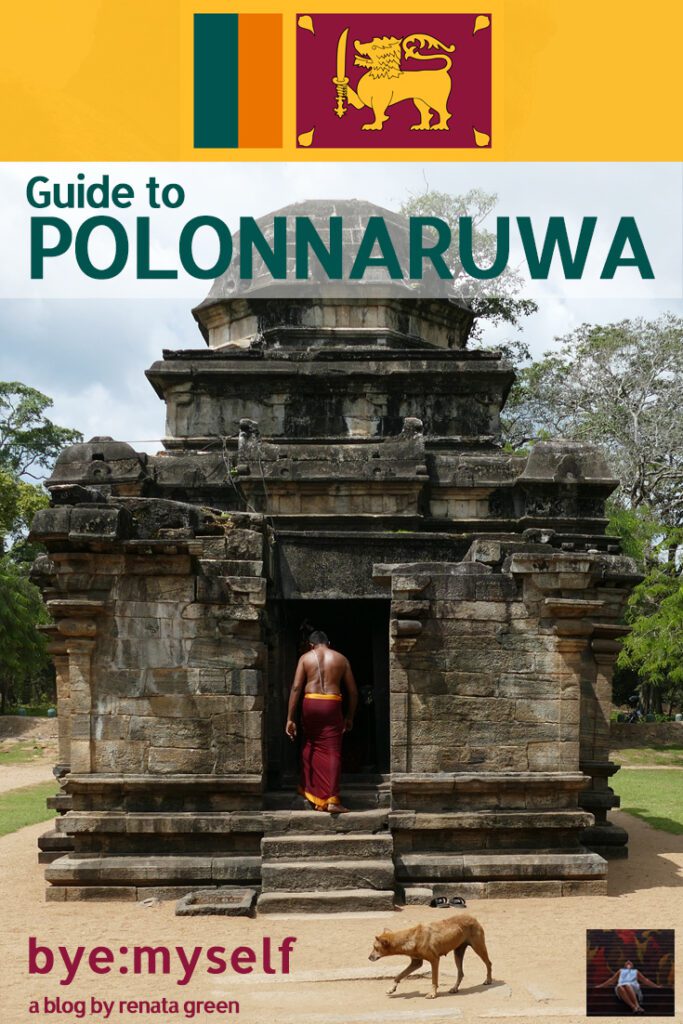
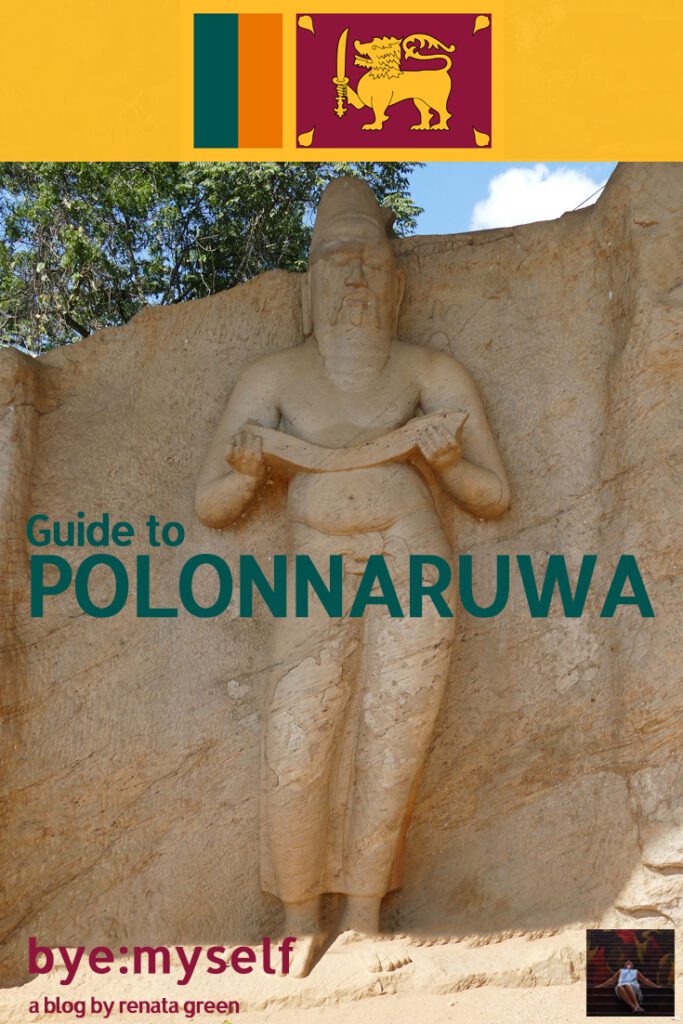

Note: I’m completing, editing, and updating this post regularly – last in January 2023.
Did You Enjoy This Post? Then You Might Like Also These:
Guide to KANDY and a Temple Hike from Embekke to Pilimathalawa
The Ski Instructor of Sri Lanka
Guide to the Most Amazing Places in SRI LANKA
Guide to UDAWALAWE – on a Peaceful Safari
Travelling by Bus Around the World or Ride with the Devil
MIRISSA – Beach Hopping
Guide to GALLE – one of Sri Lanka’s Highlights
Guide to SIGIRIYA and a day trip to DAMBULLA
Disclaimer: I appreciate that Sri Lanka Tourism Promotion Bureau is supporting my blogger trip by supplying me with tickets to some of the main landmarks. However, all opinions on these services are mine and weren’t by any means influenced by my cooperation partner.
* I paid for my stay at the Sun Guest House their standard price, so this recommendation comes truly from the heart. However, if you book using this link, I’ll get a small commission from booking.com – I wouldn’t take a small commission from these lovely people who make a living from their small guest house.



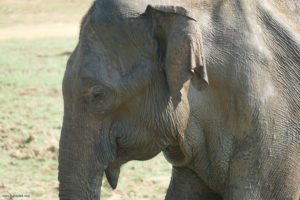




Have you ever thought about writing an e-book or guest authoring on other websites? I have a blog centered on the same ideas you discuss and would really like to have you share some stories/information. I know my viewers would appreciate your work. If you are even remotely interested, feel free to send me an email.
Thanks for reaching out, I’ll look into it as soon as I can. Greetings to beautiful Sri Lanka 🙂